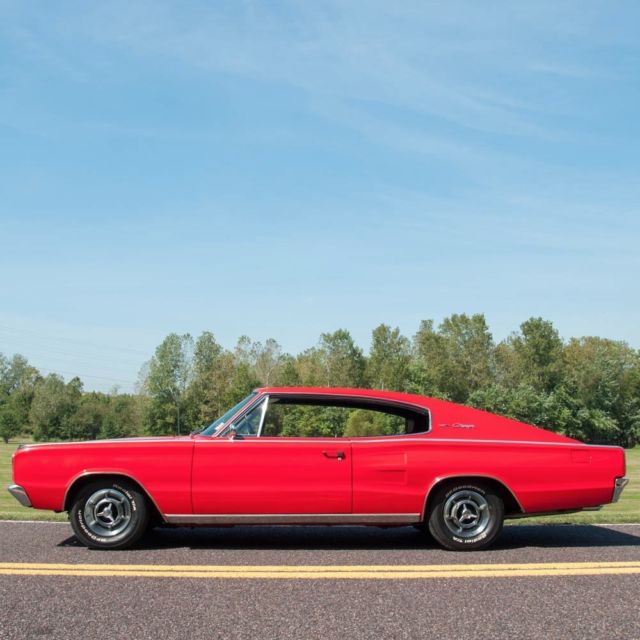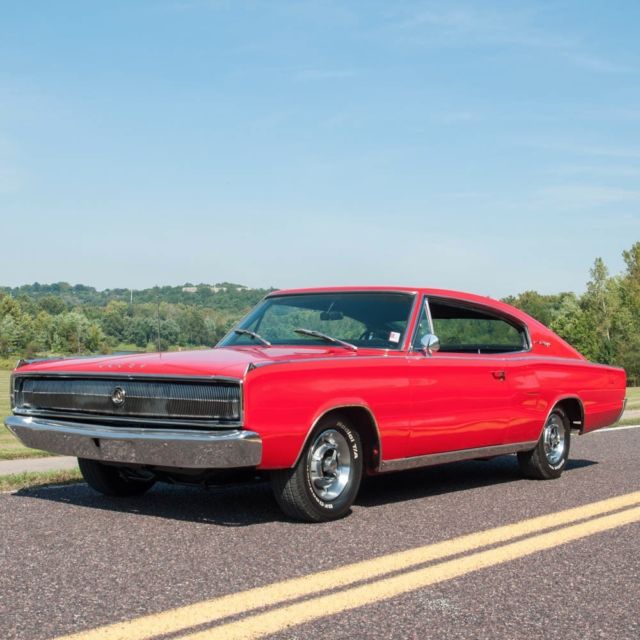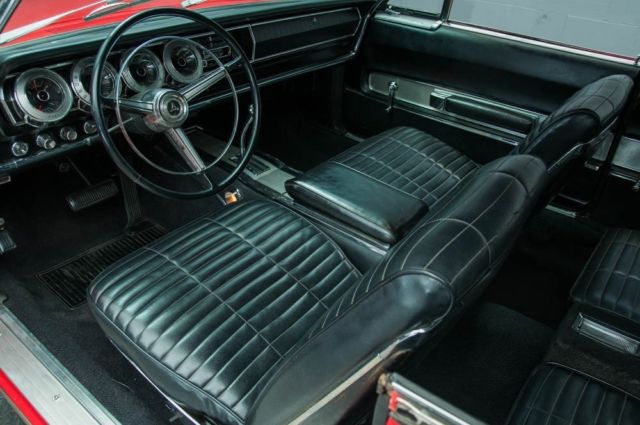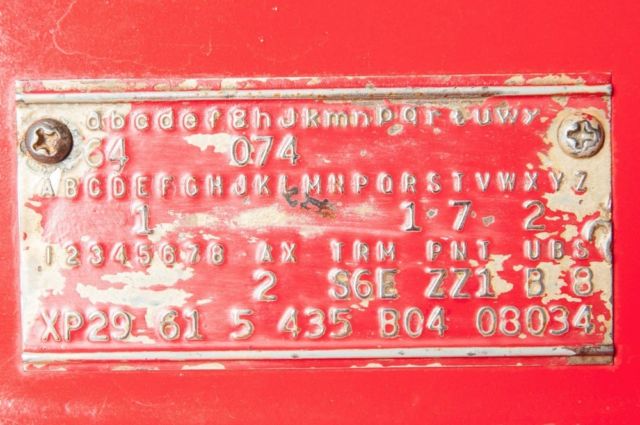1967 Dodge Charger Fastback, 383 V8, 3-spd Auto, Bucket Seat Car! LOOK
1967 Dodge Charger Charger Fastback
1967 Dodge Charger Fastback Description1967 Dodge Charger Fastback
Viper Red exterior and original black bucket seat interior 383 CID V-8 engine with Edelbrock air cleaner, dual-plane intake and 750 CFM four-barrel carburetor, Hedman headers, Comp Cams Extreme Energy camshaft, 2.5″ exhaust, Flowmaster 40 Series Mufflers and Mopar Performance electronic ignition Torqueflite 727 three-speed automatic transmission with Mopar performance torque converter and B&M shift kit New dash pad installed Headlight door and wiper motors rebuilt recently Electro-luminescent gauges have been professionally restored and installed ($2,300 receipt)Looking for a 1960s Mopar car to lead your own Dodge Rebellion? MotoeXotica Classic Cars is proud to present this 1967 Dodge Charger Fastback.
This Charger was professionally painted Viper Red in 2013. There’s a blemish on the passenger door but overall, the paint is still in very good condition. There’s a chip in the windshield but overall, its glass panels are in good order and the vehicle’s lights are in good shape but the wide taillights show some patina. The chrome bumpers are in decent, original condition with some blemishes. Car rides on BFG Radial T/A tires, size 215/70R14 surrounding factory steel wheels with factory hubcaps. The body panels are straight and in good order, the engine bay is tidy and the battery looks new. Trunk area looks tidy, too.
In that bay is a Mopar 383 CID V-8 engine with an Edelbrock air cleaner, Performer RPM Dual-plane intake manifold, and 750 CFM four-barrel carburetor, Hedman headers, a Competition Cams Extreme Energy Camshaft, 2.5-inch exhaust, Flowmaster 40 Series Mufflers and Mopar Performance electronic ignition. Backing up the engine is a Torqueflite 727 three-speed automatic transmission with a Mopar Performance torque converter and a B&M shift kit. The motors for headlight doors and the windshield wipers have been rebuilt (October 2013).
Inside, the original black vinyl interior looks good. The front bucket and the rear folding bucket seats are in good shape, as does the matching carpet, headliner, three-spoke steering wheel, door panels, center console and shifter. The dashboard has a new pad and insulation (April 2011) and the car’s electro-luminescent gauges have been professionally restored and installed (August 2011) but the fuel, oil pressure and temperature gauges are inoperable. A RetroSound AM/FM stereo completes the interior.
The 1967 model year Charger received minor changes. Outside, new fender-mounted turn signals were introduced and this would serve as the main external identifier between a 1966 and 1967 Charger. A vinyl roof became available. Inside, the full length console was eliminated to satisfy customer complaints about the difficulty for entry and exit from the back seats. It was replaced with a regular sized console. Bucket seats were standard, but a folding armrest/seat and column shifter was an option allowing three people to sit up front.
The 440 “Magnum” was added and the 361 CID V-8 was replaced by a 383 CID engine. The 440 was rated at 375 horsepower with a single four-barrel carburetor. The 318 two-barrel “LA” Chrysler engine was now the base engine with wedge-shaped combustion chambers, unlike the previous 1966 polyspherical (or “poly”) design, it was rated at 230 horsepower. The 383 4-barrel rated at 325 horsepower and the 426 Street Hemi rated at 425 horsepower remained as options. A mere 27 Chargers were built with the 426 engine.
Sales of the 1967 Chargers dropped to half of the previous introductory half-year with a total of 15,788 units. According to automotive historian Patrick Foster, both the AMC Marlin and the very similar looking first generation Dodge Charger “flopped on the market as sporty car buyers were showing their preference for compact pony cars.”
During the early-1960s, automakers were exploring new ideas in the personal luxury and specialty car segments. Chrysler, fast to enter the specialty car market, selected their Dodge Division to enter the marketplace with a bigger model to fit between the “pony car” Ford Mustang and the “personal luxury” Ford Thunderbird. The intention was to use the B-body for a sporty car with fastback look while sharing as much of their existing hardware as possible.
The fastback Charger was introduced in mid-season of the 1966 model year “in retaliation to the AMC Marlin, Ford Mustang, and Plymouth Barracuda”, but even though based on the existing Coronet, “it was style-wise a complete departure from the Dodge’s mainstream cars.” The 1965 Rambler Marlin, along with the Dodge Charger that arrived during the 1966 model year, were “the two cars set the standard for radical fastback design in American mid-size automobiles.” According to automotive historian and author, Richard M. Langworth, “because it was an intermediate like the Rambler Marlin, the Charger could have been an aesthetic disaster, but long side windows prevented its sweeping roof from looking too heavy.”
Burt Bouwkamp, Chief Engineer for Dodge during the 1960s and one of the men behind the Dodge Charger, related his experience during a speech in July 2004.
Lynn Townsend was at odds with the Dodge Dealers and wanted to do something to please them. So in 1965 he asked me to come to his office – for the second time. He noted that one of the Dodge Dealer Council requests was for a Barracuda type vehicle. The overall dealer product recommendation theme was the same – we want what Plymouth has. The specific request for a Mustang type vehicle was not as controversial to Lynn. His direction to me was to give them a specialty car but he said ‘for God’s sake don’t make it a derivative of the Barracuda’: i.e. don’t make it a Barracuda competitor.
So the 1966 Charger was born.
“We built a Charger ‘idea’ car which we displayed at auto shows in 1965 to stimulate market interest in the concept. It was the approved design but we told the press and auto show attendees that it was just an “idea” and that we would build it if they liked it. It was pre-ordained that they would like it.”
Competition to this car in 1967 included AMC’s Javelin, Chevrolet’s Camaro, Ford’s Mustang, Plymouth’s Barracuda and Pontiac’s Firebird.
This car is currently located at our facility in St. Louis, Missouri. Current mileage on the odometer shows 67,337 miles. It is sold as is, where is, on a clean and clear, mileage exempt, Texas title. GET OUT AND DRIVE!!!
VIN: XP29G72175982
Note: Please see full terms and conditions listed below that pertain to the purchase of any said vehicle, thank you.
- Make: Dodge
- Model: Charger
- SubModel: Charger Fastback
- Type: Coupe
- Trim: Charger Fastback
- Year: 1967
- Mileage: 67,337
- VIN: XP29G72175982
- Color: red
- Engine size: 383 V8
- Number of cylinders: 8
- Transmission: Automatic
- Drive type: RWD
- Interior color: black
- Vehicle Title: Clear Want to buy? Contact seller!











